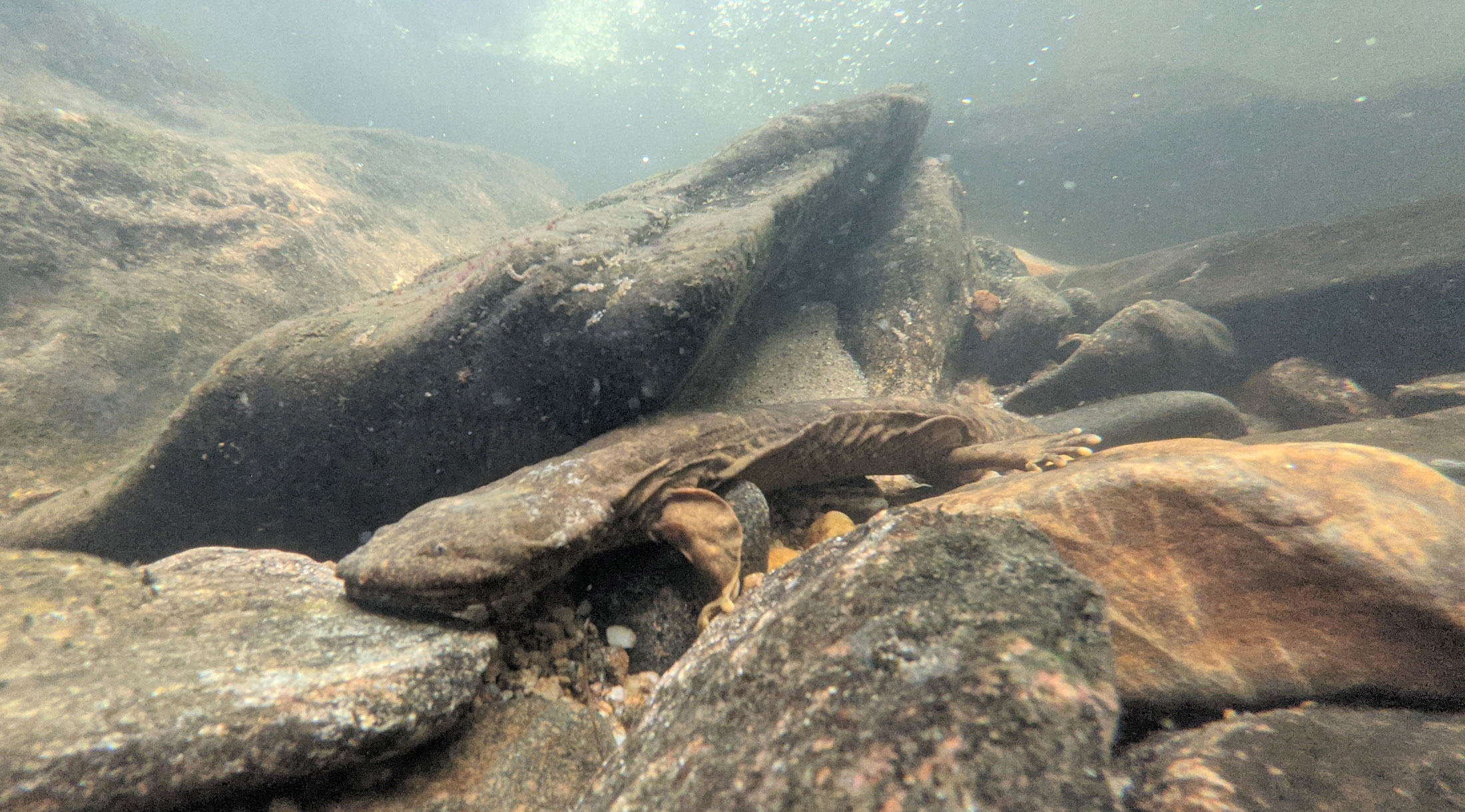
By now, the story of Hurricane Helene is a tragically familiar one: the endless rain, the swollen rivers, the angry water indiscriminately destroying lives and homes. The storm killed more than 230 people across five states, including 104 confirmed dead in North Carolina and 18 in Tennessee.
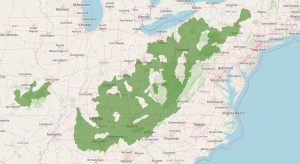
But humans aren’t the only species whose communities were ravaged by the floodwaters. Helene devastated some of the few remaining healthy populations of an iconic Appalachian species—the eastern hellbender. The species was in trouble even before the hurricane hit. Based on data gathered prior to Helene, the US Fish and Wildlife Service issued a December 13, 2024, proposal to list the giant salamander as an endangered species.
“The best populations across the species’ entire 15-state range were in Western North Carolina,” said Will Harlan, southeast director and senior scientist for the Center for Biological Diversity, a nonprofit based in Tucson, Arizona, that works to decrease threats to biodiversity worldwide. “This was the one place where there were a few populations that were relatively stable and reproducing. Helene changed all that. The very strongholds that were left for hellbenders were exactly the same places that were hit hardest by Helene. That’s just been tragic, and why this listing is even more timely and important.”
Far eastern Tennessee had also held prime hellbender habitat, with populations thriving in the Nolichucky, Holston, and Doe rivers, all of which suffered Helene’s wrath. This “critical stronghold” was severely damaged by the storm, Harlan said.
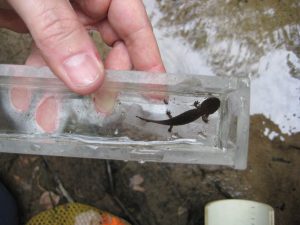
While Great Smoky Mountains National Park hosts several robust populations of hellbenders, many of its streams are too high in the watershed to offer prime hellbender habitat. But unlike many other parts of Western North Carolina, the park was largely spared severe damage from Helene. Now the park’s protected waterways are more critical than ever to the hellbender’s survival.
“We’re getting pinched on both sides at this point,” said Jonathan Cox, wetlands biology technician for the park. “Whereas before the Tennessee side was getting hammered outside the park due to development, now with the huge impact Helene has had on areas outside the park in North Carolina, I would agree that our populations within the park boundary are that much more important.”
The eastern hellbender, an aquatic salamander whose adults reach an average length of 20 inches—slightly less than two footballs laid end to end—has been in decline for decades. Feeding primarily on crayfish and breathing through its skin, the species is extremely sensitive to environmental degradation. And its long life cycle—hellbenders can live more than 30 years in the wild and need about six years to reach sexual maturity—means that populations can take a long time to recover once degraded.
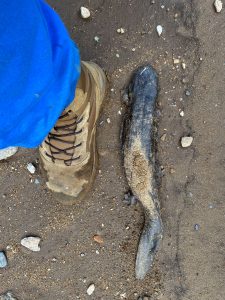
One of two hellbender subspecies in the United States, the eastern hellbender was once abundant across its 15-state range, with 626 populations documented in the Appalachian region from northern Alabama through central New York; a separate population in Missouri was listed as endangered in 2021. The Ozark hellbender, which occurs in Missouri and Arkansas, was listed in 2011. In its review of the eastern hellbender’s status, the USFWS found that only 59 percent of the original 626 populations remain, and that, of those, nearly two-thirds are in decline. Only 12 percent of existing populations are known to be stable and reproducing.
Following Helene, those numbers are likely even lower. In Western North Carolina, where hellbenders had been detected in more than 170 streams over the past 20 years, the region’s best hellbender habitat overlapped the area most affected by the flood, such as the Toe, Cane, and French Broad watersheds in Mitchell, Avery, Yancey, and Buncombe counties. While the full extent of the storm’s impact on hellbender populations is not yet known, Lori Williams, a wildlife biologist for the NC Wildlife Resources Commission who has spent much of the past two decades working on hellbender conservation, said that it’s likely severe.
“Knowing what we had with this crown jewel for this species, and then to get hammered as we did in such a short period of time, and to see so much of that destroyed, is mind boggling,” she said. “We have not even wrapped our brains around what we’re dealing with yet.”
The flood tore through in the middle of hellbender breeding season, blowing away nests full of eggs. Many adults were either swept along with the debris or forced to seek refuge in developed areas above the waterline, where they later desiccated and died. Williams has received “reliable reports” of as many as 100 hellbenders at a time found dead in debris piles across the region.
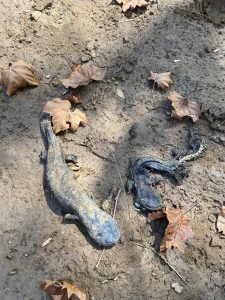
Due to the species’ slow rate of maturity, replacing damaged populations would be a long process under even the best of conditions. However, the flood’s aftermath is expected to exacerbate the issues that had already been spurring the hellbender’s decline. In its December listing proposal, the USFWS identified sedimentation as the biggest threat facing the species, followed by water quality degradation, habitat destruction, and direct mortality and removal due to “collection, persecution, recreation, or gravel mining.”
“I think the thing that has been driving their decline the most is sedimentation, which is really water pollution—it’s just dirt going in the streams,” said JJ Apodaca, executive director of the Amphibian and Reptile Conservancy, a nationwide nonprofit that supports conservation in the US. “Many aquatic creatures need these tiny interstitial spaces between rocks for their young to survive and thrive, and once they get filled up with dirt and silt, the next generation doesn’t survive. When you lose reproductive ability, the population starts crashing pretty quickly.”
Helene caused extreme sedimentation as the floodwaters ripped up trees and shrubs, tore up the riverbed, and carried along loose particles for deposit downstream. These particles included pollution from fuel oil, sewage, and chemical runoff from industrial sites, much of which likely settled in the waterways that hellbenders and other aquatic wildlife depend on for survival. Meanwhile, wind and water damaged an estimated 822,000 acres of forest in the region, according to a North Carolina Forest Service estimate, amplifying the acreage susceptible to ongoing sedimentation. Some of these vanished forests once grew alongside streams and rivers, shading the water and keeping it within the cooler temperature range required by species like the hellbender.

“The scars of Helene are going to keep impacting these waterways for decades,” Apodaca said.
Harlan called December’s endangered listing proposal an “exciting and well-deserved” development after years of effort from his organization. The Center for Biological Diversity first petitioned the USFWS to list the hellbender in 2010, but in 2019, the agency determined that the eastern hellbender did not meet the criteria for listing, publishing a final rule to that effect in March 2021. Five conservation organizations, including the Center for Biological Diversity, filed a lawsuit challenging the rationale used to make this decision, and a federal court ruled in their favor in 2023, vacating the 2019 finding. The USFWS proposed the endangered listing on December 13, 2024.
The agency has one year to either publish a final rule, withdraw the proposal, or issue an extension of up to six months. A public comment period is open through February 11.
Harlan called the proposed listing a “beacon of hope” not only for the hellbender, but for the rivers and streams that are the “lifeblood” of so many communities ravaged by the storm. A designation would unlock funding to restore hellbender habitat, which would be accomplished by resurrecting the high-quality watersheds the region was known for prior to Helene.

“There’s a possibility that hellbender habitat funding could help restore clean drinking water and help restore riparian areas that have been especially hit hard by Helene,” he said. “I think both hellbenders and Helene-impacted communities can bounce back with the help of this listing.”
Though the challenges facing the hellbender are severe, wildlife professionals working toward the species’ recovery are optimistic about the future. The hellbender has a large, collaborative community of supporters and researchers behind it, with new research and conservation techniques being developed all the time. It is possible to save it, they say.
“As long as we use some common sense and our best scientific knowledge, I think we will have success in a lot of places,” Williams said. “I don’t think we’re ever going to get back completely what we’ve lost with Helene or even, bigger picture range-wide, what other states have lost over time. But we’re not going to lose this animal off the face of the earth.”
Read the second part of the series, Park embarks on cutting edge hellbender study.
Subscribe to get the latest posts sent to your email.
The Great Smokies Welcome Center is located on U.S. 321 in Townsend, TN, 2 miles from the west entrance to Great Smoky Mountains National Park. Visitors can get information about things to see and do in and around the national park and shop from a wide selection of books, gifts, and other Smokies merchandise. Daily, weekly, and annual parking tags for the national park are also available.